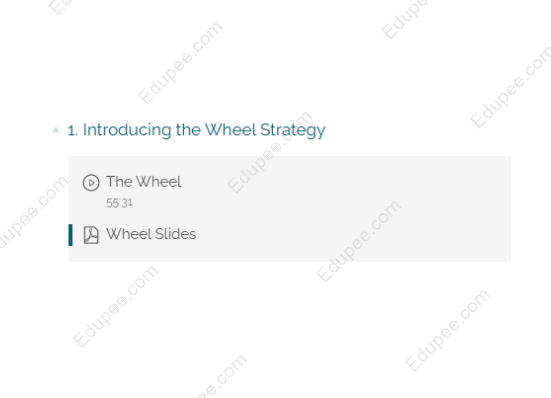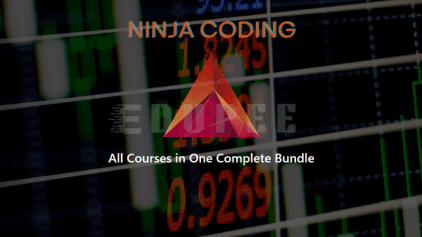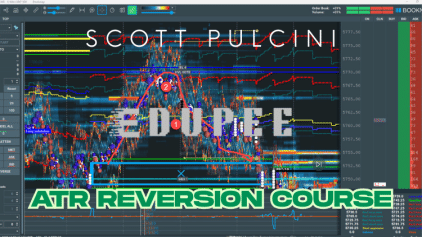The Wheel Strategy by Dan Sheridan – Get Instant Access
Content Proof:
An In-Depth Review of the Wheel Strategy by Dan Sheridan
In the fast-paced world of options trading, finding a reliable and repeatable method to generate income can often feel elusive. That’s where the Wheel Strategy, popularized by renowned options trader Dan Sheridan, comes in. This structured approach offers traders a systematic way to create steady income by combining two powerful tools: selling cash-secured puts and writing covered calls. By cycling through these steps, traders can turn market fluctuations into opportunities while maintaining a disciplined framework for risk management.
More than just a technique, the Wheel Strategy equips traders with both consistency and confidence—allowing them to approach the markets with clarity rather than uncertainty. In this guide, you’ll explore the mechanics of how the strategy works, the potential rewards it offers, the risks to be mindful of, and how to put it into practice effectively. With this knowledge, you’ll be better prepared to decide whether the Wheel Strategy deserves a place in your trading playbook.
Overview of the Wheel Strategy
The wheel strategy is not merely a trading tactic; it’s a comprehensive framework that emphasizes risk management and consistent income generation. It revolves around a repetitive cycle that can potentially yield regular income. The fundamental steps include selling cash-secured puts, acquiring stocks, and subsequently selling covered calls.
- Selling Cash-Secured Puts:
- Initially, traders identify stocks they are prepared to own and sell put options on those stocks. Through this mechanism, they capture premiums while signaling their intent to purchase the stock at a predetermined strike price if the option gets exercised.
- The beauty of selling put options lies in its flexibility. If the underlying stock price remains above the strike price upon expiration, the put option expires worthless, allowing traders to pocket the premium without additional obligation. Conversely, if the stock price dips below the strike price, the trader must purchase the shares at the agreed price presenting an opportunity to acquire the stock at potentially lower prices.
- Owning Stocks and Selling Covered Calls:
- Once the stocks are in hand, the next phase is to sell covered calls. Traders can generate additional income through premiums on call options while still retaining ownership of the stocks.
- This step is crucial as it adds yet another layer of income generation. If the stock remains below the call’s strike price until expiration, the call option will expire worthless, enabling the trader to keep both the premium from the call and the stock. However, if the stock price climbs above the strike price, the stock will be sold at that price, locking in profits for the trader.
- Repeating the Process:
- The cycle enables traders to effortlessly transition from one stage to the next. Should the stock be sold after the covered call is executed, the wheel turns back to the beginning, where traders can sell cash-secured puts again, either on the same stock or a new one.
This cyclical movement is what distinctly characterizes the wheel strategy, offering a rhythmic yet strategic approach to options trading that appeals to both novice and seasoned traders.
Benefits of the Wheel Strategy
The Wheel Strategy offers several advantages for traders who want both consistency and control in their approach:
-
Steady Income Generation: By combining the sale of puts and covered calls, traders can create recurring cash flow opportunities. Each step of the cycle opens the door to additional income, making the strategy both flexible and dependable.
-
Built-In Risk Management: A core strength of the strategy is its focus on risk control. Traders only sell puts on stocks they’re comfortable owning, while premiums collected help lower the effective purchase cost. This provides a cushion during market pullbacks.
-
Adaptability in Different Markets: The Wheel Strategy works especially well in stable or moderately bullish conditions, where sharp price swings are less common. This makes it a valuable tool for navigating sideways markets with confidence.
Additional Advantages
- Flexibility: The strategy allows traders to pivot between different assets easily, maximizing opportunities across their portfolios.
- Educational Value: By engaging in this structured approach, traders become well-versed in options trading mechanics, boosting their market acumen.
Risks and Considerations
While the wheel strategy offers an exciting approach to trading options, it’s essential to remain cognizant of the associated risks. Understanding these will aid traders in executing a well-rounded and informed strategy.
- Capital Requirements: A significant caveat of the wheel strategy is the need for substantial capital. Traders must have sufficient funds not only to sell cash-secured puts but also to purchase shares if assigned. This requirement underscores the necessity for adequate financial resources prior to engaging in this trading practice.
- Limited Upside on Stocks: While selling covered calls can generate income, it inherently caps the profit potential. If the stock price surges beyond the call’s strike price, traders may miss out on substantial gains. This characteristic of the strategy necessitates a balanced approach to earnings versus growth potential.
- Stock Ownership Risks: Owning stocks comes with its own set of vulnerabilities. For instance, if a stock experiences a significant downturn post-purchase, even with collected premiums, traders could face losses that overshadow their earnings. This risk emphasizes the importance of prudent stock selection and vigilant monitoring of market conditions.
Considerations for Implementation
When applying the Wheel Strategy, it’s important to stay attuned to overall market sentiment, as it can greatly influence decision-making. In addition, keeping a close watch on key events—such as earnings announcements or major economic updates—can help anticipate periods of volatility that may disrupt the cycle and allow for timely adjustments.
Practical Implementation
To effectively harness the wheel strategy, traders must adhere to several best practices that solidify their approach and enhance the likelihood of success.
- Stock Selection: Prioritize stable, well-established stocks with moderate volatility. Avoiding high-growth or overly erratic stocks can protect the strategy’s integrity and contribute to better decision-making.
- Monitoring Market Conditions: Staying attuned to the broader market context and key events can keep traders informed and ready to adapt their strategies accordingly. For example, significant earnings announcements or macroeconomic reports could influence stock prices and options volatility.
- Diversification: Emphasizing diversification is critical in mitigating risks. Having a varied selection of stocks in a portfolio can cushion against individual stock movements, spreading out exposure and reducing the potential for losses.
Practical Steps for Implementation
- Establish Clear Goals: Define what you want to achieve with the strategy (e.g., a specific income target).
- Set Up Alerts: Use trading platforms to set alerts for stock price movements.
- Review Performance Regularly: Conduct periodic assessments of the strategy’s effectiveness and make adjustments as necessary.
Conclusion
To sum up, Dan Sheridan’s Wheel Strategy stands out as a practical and adaptable framework for generating steady income while keeping risk under control. By alternating between cash-secured puts and covered calls, traders are encouraged to follow a disciplined process that can lead to more consistent results over time. The true effectiveness of this approach, however, relies on thoughtful stock selection, smart capital management, and an ongoing awareness of market conditions. For traders seeking a reliable method to strengthen their options trading toolkit, the Wheel Strategy offers not only a pathway to financial growth but also a deeper appreciation for the strategic side of the markets.
This is the proof inside The Wheel Strategy by Dan Sheridan












Reviews
There are no reviews yet.